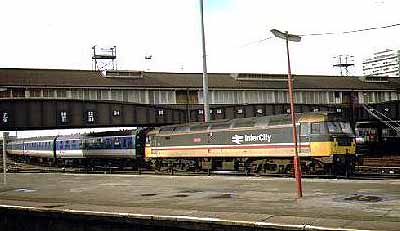The first three photos were taken in and
around Paddington Station, the
gateway to the West and Southwest of England, including Penzance, Bath,
Bristol, Oxford, and South Wales. The trains in the first two are High
Speed Trains (HST's), or, in popular parlance, '125's' because of their
capacity to run at 125mph. They entered service in 1976 and remain the
backbone of high speed service on non-electrified lines in many parts
of the country. On long routes in the 1980s they included coaches, a
buffet car and a restaurant.

The photo on the left is of a train
arriving at Euston Station, which
primarily served the West Coast Main Line to Liverpool, Scotland,
and North Wales, as well as Manchester. Note we say 'served'. Today, it
is possible to go to many parts of Britain from all the mainline
stations in London.
Here is a night exposure at Paddington.

Below are views of Kings Cross, which served the East Coast Main Line
to Scotland, Hull, and Yorkshire, and Euston.
The next two photos were taken at Liverpool Street Station, which
served trains to Colchester, Cambridge, Norwich, Ipswich, Harwich,
King's Lynn and local stations in a very beautiful part of the country.
Below are shots taken, I believe, at Clapham Junction, which serves
much of the South of England and is reportedly the busiest rail
junction in the UK.

On the left is St. Pancras Station, which served the Midlands -- if
you look carefully you can see Kings Cross int he background. The
1980s saw moves to privatize and spruce up food services at many
stations.
The picture on the left below is the Great
Northern Hotel, located between Kings Cross and St. Pancras stations.
Opened in 1854 to serve railway travelers (it had equivalents at all
the mainline stations), it was something of a
Victorian throwback when I stayed there. Today it has been refurbished
and is part of the Best Western chain. The next four photos below
were taken on the line that served Colchester, Cambridge, Ely, Ipswich,
Norwich, and Kings Lynn out of Liverpool Street.

|

|

|

|

On the left below is the Milton Keynes
station, opened in the 1980s to serve one of Britain's 'new towns' in
the Midlands.
The next three photos were taken in and near Crew, a main railway
junction and shops city on the West Coast Main Line. Here trains split
off to Manchester. The third of these pictures shows the abandoned
Advanced Passenger Train, a failed effort begun in 1967 to produce a
155mph train that would maximize existing infrastructure as an
alternative to building entirely new high speed lines, as in France.
Over 20 years later one can still see the increasingly deteriorted
symbol of failure from the train.

|

|

|

|

On the left is a train serving Wigan and
Manchester from Southport, and on the right a Merseyrail commuter
train, pulling into the Hillside Station in Southport on its run to
Liverpool Lime Street. Today, trains run from Southport through
Manchester to its airport and Merseyrail system has been privatized.
When I last rode the line, in 2002, the old dmu's on the left were
still in service for some runs.
Next BR Page



























